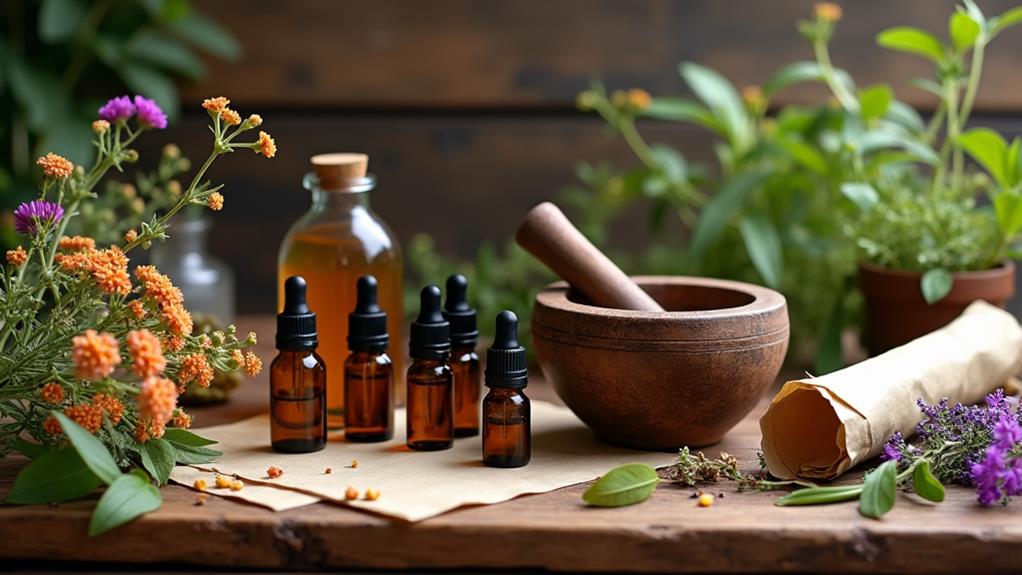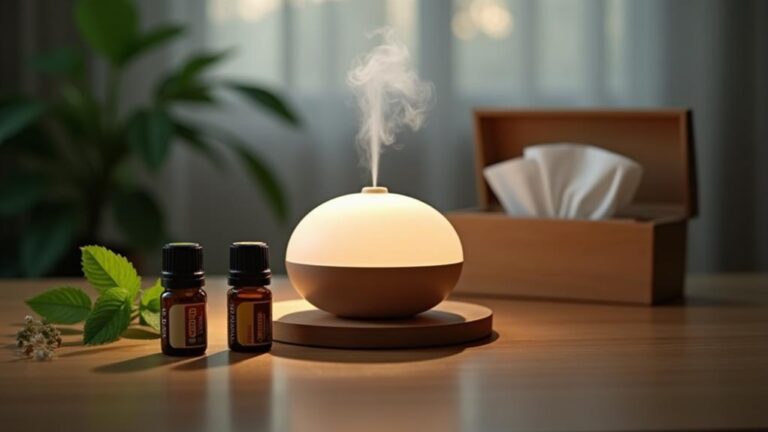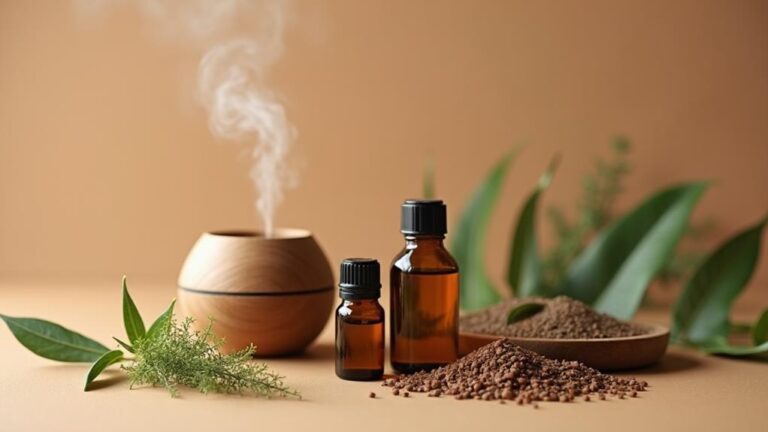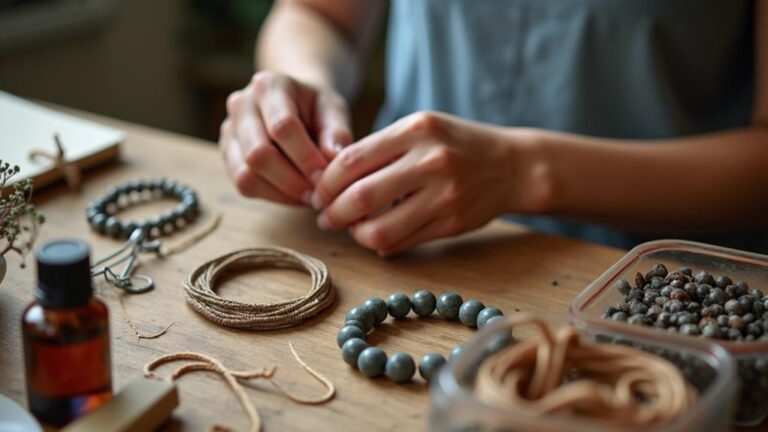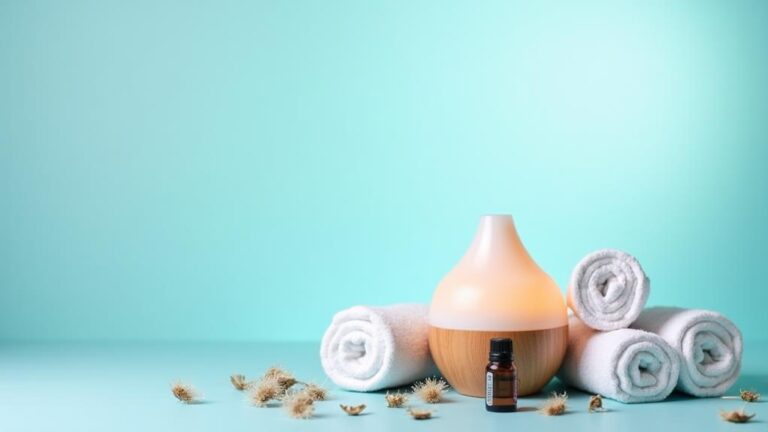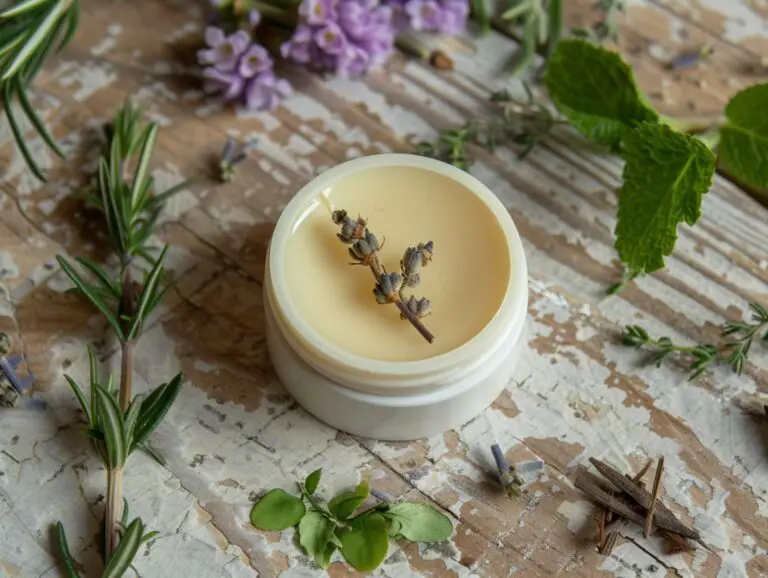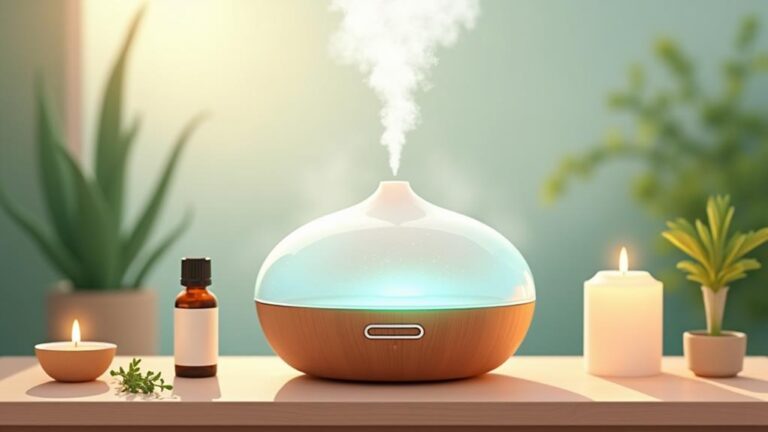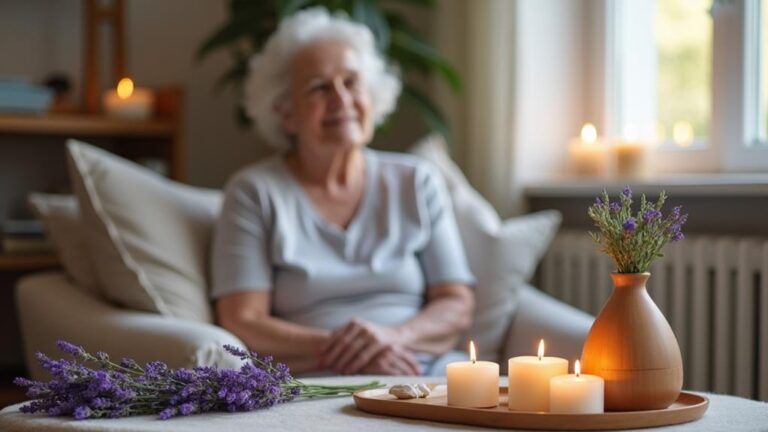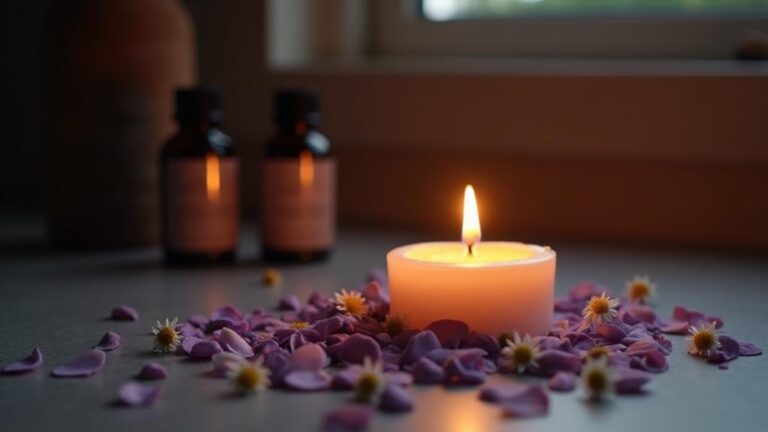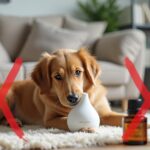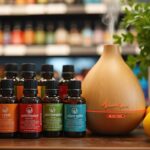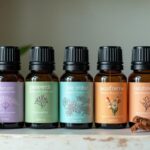Imagine creating a custom aromatherapy oil blend that eases your stress and promotes relaxation after a long day. Let's say you want to craft a calming blend to help you unwind before bed. You've heard that lavender and chamomile essential oils can work wonders, but you're not sure where to start or how to combine them effectively. By following a few simple steps, you can create a unique blend that's tailored to your specific needs. But first, you need to determine your aromatherapy goals and choose the right carrier oil base – and that's just the beginning.
Key Takeaways
- Identify your aromatherapy goal, such as relaxation or energy boost, to determine the best essential oils and carrier oils to use.
- Choose a carrier oil based on skin type, therapeutic benefits, and shelf life to complement your essential oils and enhance blend effectiveness.
- Select essential oils that align with your goal, considering their unique properties, scent profiles, and therapeutic benefits, such as calming or uplifting effects.
- Blend essential oils in a harmonious ratio, using top, middle, and base notes to create a balanced and effective blend, such as 30% top notes, 40% middle notes, and 30% base notes.
- Perform a patch test and follow safety guidelines, including diluting essential oils in a carrier oil, to ensure safe and effective use of your aromatherapy blend.
Determine Your Aromatherapy Goals
As you venture on your aromatherapy journey, this is vital to define what you hope to achieve, since different goals require distinct approaches.
Aromatherapy benefits can vary greatly depending on your personal goals, whether it's to reduce stress, improve sleep, or alleviate pain.
Take a moment to reflect on what you want to achieve through aromatherapy.
Are you seeking relaxation and calmness, or perhaps a energy boost?
Do you want to address specific health concerns, such as anxiety or digestive issues?
Choose a Carrier Oil Base
You'll want to choose a carrier oil that complements your essential oil blend, so consider the selection criteria that matter most to you, such as skin type, therapeutic benefits, and shelf life.
The properties of your base oil will impact the overall effectiveness of your blend, so crucially, you need to understand how they'll interact with your essential oils.
Oil Selection Criteria
Selecting the right carrier oil base is crucial to creating an effective aromatherapy oil blend, since it directly impacts the blend's therapeutic benefits and shelf life.
When choosing a carrier oil, you'll want to ponder your personal fragrance profiles and scent preferences. Do you prefer light, floral notes or rich, earthy undertones?
Some carrier oils, like sweet almond oil, have a mild, nutty aroma, while others, like jojoba oil, have a neutral scent. If you're looking to create a blend with a specific fragrance profile, you'll want to select a carrier oil that complements or enhances the aroma of your essential oils.
For example, if you're creating a calming blend with lavender essential oil, a light, gentle carrier oil like grapeseed oil might be a good choice. On the other hand, if you're creating an invigorating blend with peppermint essential oil, a richer carrier oil like coconut oil could be a better fit.
Base Oil Properties
The foundation of an aromatherapy oil blend lies in the carrier oil base, which substantially influences the final product's therapeutic benefits, shelf life, and overall character.
When choosing a carrier oil base, you'll want to weigh the unique properties of each oil to verify it complements your essential oil selection.
Different carrier oils are rich in various fatty acids, which affect the blend's absorption rate, moisturizing properties, and stability.
For instance, sweet almond oil is high in oleic acid, making it ideal for dry skin types, while jojoba oil's balanced fatty acid profile suits most skin types.
Grapeseed oil, rich in polyunsaturated fatty acids, is lightweight and easily absorbed, making it perfect for oily skin.
Coconut oil, with its high lauric acid content, offers antimicrobial and anti-inflammatory benefits.
Blending Ratios Matter
Crafting the perfect aromatherapy oil blend is an art that requires attention to detail, and a crucial aspect of this process is determining the ideal blending ratio. Many aromatherapy enthusiasts fall prey to blending myths, but crucially, one must understand the importance of ratio guidelines.
When it comes to choosing a carrier oil base, you'll want to select one that complements your essential oils. The general rule of thumb is to use 2-3% essential oils and 97-98% carrier oils. However, this can vary depending on the desired strength and purpose of your blend.
| Essential Oil Percentage | Carrier Oil Percentage |
|---|---|
| 1% | 99% |
| 2% | 98% |
| 3% | 97% |
| 5% | 95% |
| 10% | 90% |
Select Essential Oils for Blending
When selecting essential oils for blending, you'll want to weigh their unique properties, such as their therapeutic benefits, scent profiles, and intensity levels.
You'll also need to think about how these individual oils will interact with each other, as some combinations can create powerful synergy effects that enhance their benefits.
Essential Oil Properties
As you explore into the world of aromatherapy oil blending, it's crucial to understand the unique properties of individual essential oils.
Each essential oil has its distinct scent profile, which is often categorized as floral, citrus, woody, or spicy. These scent profiles can evoke emotions, influence moods, and even trigger memories.
Beyond their aromatic appeal, essential oils also offer therapeutic benefits.
For instance, lavender oil is known for its calming effects, while peppermint oil can help alleviate headaches and improve focus.
Some essential oils have antibacterial and anti-inflammatory properties, making them ideal for skincare blends.
Others, like eucalyptus oil, can help ease respiratory issues.
When selecting essential oils for blending, consider their individual properties and how they'll interact with each other.
Think about the specific therapeutic benefits you want to achieve and the scent profile you're aiming for.
Oil Synergy Effects
Combine essential oils that complement each other in your blends, and you'll tap the full potential of aromatherapy.
When you select essential oils that work in harmony, you can create unique scent combinations that enhance the therapeutic benefits of each individual oil. This synergy effect is the foundation of creating effective aromatherapy oil blends.
- Create fragrance harmonies that calm the mind and soothe the body by blending lavender with bergamot and ylang-ylang.
- Unite citrus essential oils like lemon, grapefruit, and orange to uplift and energize the spirit.
- Pair earthy patchouli with floral geranium to balance and ground the emotions.
Blending Oil Families
Three primary oil families – floral, citrus, and earthy – serve as the cornerstone of aromatherapy blending. These oil groups are categorized into family categories, each with distinct characteristics that enhance or contrast with one another. Understanding these families helps you create harmonious blends that evoke desired emotions and effects.
| Oil Family | Characteristics |
|---|---|
| Floral | Delicate, sweet, uplifting (e.g., rose, lavender) |
| Citrus | Invigorating, revitalizing, uplifting (e.g., lemon, grapefruit) |
| Earthy | Grounding, woody, calming (e.g., patchouli, cedarwood) |
When selecting essential oils for blending, consider the family categories. For instance, combining floral oils like rose and lavender can create a calming, romantic blend. Alternatively, pairing citrus oils like lemon and grapefruit can produce an invigorating, revitalizing scent. By understanding the characteristics of each oil family, you can create unique blends that cater to specific needs and moods.
Understand Essential Oil Properties
Within the domain of aromatherapy, understanding essential oil properties is crucial for creating effective oil blends that cater to your specific needs.
You'll want to ponder the unique characteristics of each essential oil type, as this knowledge will help you create harmonious blends that achieve your desired outcome.
- Top notes: These oils are light, uplifting, and often used to evoke feelings of freshness and energy.
- Middle notes: These oils are rich, balancing, and often used to promote emotional harmony and relaxation.
- Base notes: These oils are deep, grounding, and often used to promote feelings of calmness and tranquility.
When exploring essential oil properties, you'll discover that each oil has its own distinct personality, influenced by factors such as its botanical family, method of extraction, and chemical composition.
Understanding these oil characteristics will enable you to create blends that not only smell amazing but also provide the therapeutic benefits you're looking for.
Consider Blending Ratios and Strength
How do you guarantee your aromatherapy blends pack the right punch without overwhelming your senses? The key lies in understanding blending ratios and strength. By following blending guidelines, you can create harmonious fragrance profiles that effectively address specific needs without being overpowering.
A general rule of thumb is to use a 3:2:1 ratio for top, middle, and base notes, respectively. This means that for every 3 parts of top notes, you'll use 2 parts of middle notes and 1 part of base notes. However, this is just a starting point, and you may need to adjust the ratio based on the specific essential oils you're using.
Here's a breakdown of common blending ratios:
| Top Notes | Middle Notes | Base Notes |
|---|---|---|
| 30% | 40% | 30% |
| 20% | 50% | 30% |
| 40% | 30% | 30% |
| 25% | 45% | 30% |
| 35% | 35% | 30% |
Research Safety Guidelines and Precautions
As you craft your aromatherapy oil blends, it's equally important to weigh the safety guidelines and precautions that come with working with essential oils.
Aromatherapy risks can be minimized by understanding oil interactions and potential contraindications.
- Pregnancy and Breastfeeding: Certain essential oils can stimulate the uterus or affect hormone levels, so it's vital to research which oils are safe for use during pregnancy and breastfeeding.
- Medication Interactions: Essential oils can interact with medications, such as blood thinners, diabetes medications, and blood pressure medications, which can lead to adverse effects.
- Skin Sensitivity and Allergies: Always perform a patch test before using a new essential oil, as some oils can cause skin irritation, allergic reactions, or even phototoxicity.
Prepare Your Blending Workspace
To prepare your blending workspace, start by clearing a clean surface where you can lay out your essentials without distractions.
Organize your essential oils by grouping similar scents or categories, making it easy to access the oils you need as you blend.
Clean Blending Surface
Before you begin crafting your aromatherapy oil blends, take a moment to prepare your workspace.
A clean blending surface is essential for creating effective and safe blends.
A cluttered and dirty workspace can lead to contamination, spills, and mistakes, which can compromise the quality of your blends.
To guarantee a clean blending surface, make sure to:
- Wipe down your work surface with a damp cloth to remove any dust or debris
- Remove any unnecessary items that could get in the way of your blending process
- Use a clean and dust-free surface, such as a glass or stainless steel countertop
Essential Oil Organization
With your clean blending surface in place, turn your attention to the essential oils that will bring your aromatherapy blends to life. It's time to organize your essential inventory, ensuring easy access to the oils you need. Begin by categorizing your oils into groups, such as calming, uplifting, and energizing. This oil categorization will help you quickly identify the best oils for your blends.
| Oil Category | Examples |
|---|---|
| Calming | Lavender, Chamomile, Bergamot |
| Uplifting | Grapefruit, Lemon, Geranium |
| Energizing | Peppermint, Eucalyptus, Rosemary |
Store your essential oils in a cool, dark place, away from direct sunlight and heat. Use a carrying case or storage box to keep your oils tidy and protected. Label each oil with its name, expiration date, and any relevant safety information. With your essential oils organized, you'll be able to focus on blending and creating your unique aromatherapy recipes.
Measure and Mix Your Blend
Several factors come into play when measuring and mixing your aromatherapy oil blend.
You'll need to weigh the ratio of essential oils to carrier oils, the strength of each essential oil, and the desired therapeutic benefits.
To verify measurement accuracy, use a digital scale or measuring cups specifically designed for aromatherapy blending tools.
- Use high-quality measuring cups or a digital scale to verify accurate measurements.
- Label each component before adding it to the blend to avoid confusion.
- Start with small quantities and adjust as needed to achieve the perfect blend.
When mixing your blend, start by adding the essential oils to the carrier oil.
Use a glass stirring rod or spoon to gently combine the ingredients. Be patient and take your time, as this process can be meditative and enjoyable.
As you mix, focus on the aromas and textures coming together to create your unique blend.
Remember to record your measurements and ratios so you can replicate the blend in the future.
Store Your Custom Blend Properly
Now that you've carefully crafted your unique aromatherapy oil blend, it's time to guarantee its potency and shelf life by storing it properly.
You've invested time and effort into creating a custom blend that addresses your specific needs, so vital is to preserve its quality.
Transfer your blend to a dark glass container with a tight-fitting lid.
Glass is an ideal material as it won't react with the oils or absorb their scent.
Dark storage is vital as light can cause the oils to degrade, leading to a loss of potency and aroma.
Avoid storing your blend in direct sunlight, near heat sources, or in humid environments.
Label the container with the blend's name, ingredients, and date.
This will verify you can easily identify the blend and track its shelf life.
Store the container in a cool, dry place, such as a cupboard or drawer.
Test and Refine Your Creation
Your custom aromatherapy oil blend is finally ready to be put to the test. To guarantee the best results, verify the blend's performance and make any necessary adjustments to achieve the desired therapeutic benefits and scent profile.
- Take note of the blend's aroma strength, character, and any undertones
- Evaluate how the blend makes you feel, whether it's uplifting, calming, or energizing
- Pay attention to how the scent lingers and evolves over time
When testing, consider scent profiling, which involves analyzing the top, middle, and base notes of the blend.
This will help you identify areas that need refinement.
You may need to make blending iterations, adjusting the ratio of essential oils or adding new ones to achieve the perfect balance.
Don't be discouraged if it takes a few attempts to get it right – refining your blend is a natural part of the creation process.
Frequently Asked Questions
Can I Use Expired Essential Oils for Blending?
You shouldn't use expired essential oils for blending, as their shelf life has passed, and they might've lost potency, changed composition, or even gone rancid, which can affect the blend's quality, aroma, and potentially cause skin irritation.
Are Aromatherapy Oil Blends Safe for Pets to Inhale?
You, as a responsible pet owner, should exercise caution when using aromatherapy oil blends around your furry friends, ensuring their animal safety by choosing pet-friendly essential oils and diluting them properly to avoid potential harm.
Can I Reuse a Dirty Blending Utensil Without Cleaning It?
Did you know 80% of illnesses are caused by poor hygiene? You're wise to ask: no, don't reuse a dirty blending utensil without cleaning it. Clean habits and utensil care are vital to avoid cross-contamination and guarantee the quality of your blends.
How Long Does It Take to See Results From Using Aromatherapy?
You'll typically start noticing the benefits of aromatherapy within 2-4 weeks, but crucially, a consistent routine must be established; as you stick to your aromatherapy timeline, you'll experience more pronounced results, and Consistency matters to release its full potential.
Can I Ingest Aromatherapy Oil Blends for Internal Benefits?
You shouldn't ingest aromatherapy oil blends for internal benefits, as it's vital to prioritize oil safety; internal use can be harmful, even toxic, without proper dilution and medical supervision, so always consult a healthcare professional before exploring internal use.
Conclusion
As you've crafted your custom aromatherapy blend, imagine the essence of serenity unfolding, like a delicate petal unfurling in the morning dew. With each carefully measured drop, your creation whispers promises of relaxation, rejuvenation, or focus, tailored to your unique needs. Your bespoke blend now awaits, a treasure in a dark glass vial, ready to transport you to a domain of balance and harmony, where the rhythms of life align in perfect symphony.


